Types of Pantry Bugs (With Pictures) – Identification and Treatment Guide
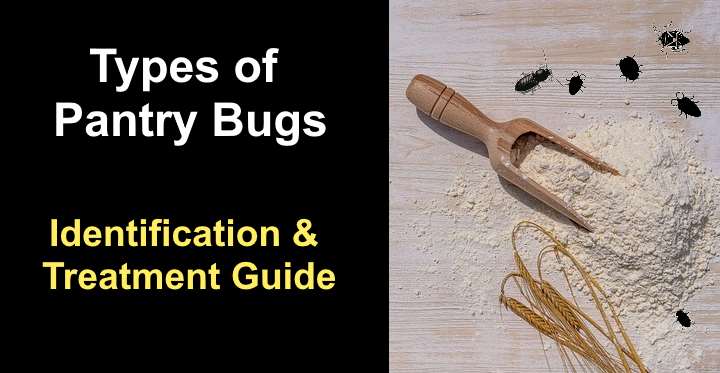
Pantry bugs are tiny insects like beetles, weevils, moths, ants, and worms that can infest foodstuffs. These little pantry bugs live in flour, dried grains, cereal products, pasta, rice, spices, crackers, and powdered foods. Unfortunately, identifying and getting rid of pantry bugs is challenging. The little creepy crawlies are hard to spot, and their eggs are often microscopic.
Unfortunately, pantry bugs usually get into your food at the warehouse, processing plant, during transportation, or the store. So, the chances are that you unwittingly brought the pests home yourself. Also, because the eggs are virtually undetectable, you may not notice the tiny black or brown bugs until you see them crawling around your pantry.
The best way to treat small pantry bugs is to discard contaminated foodstuffs and thoroughly clean all surfaces. Because disgusting tiny pantry bugs in the kitchen quickly multiply, keeping dried or powdered foods in sealable, airtight containers can help prevent an infestation.
Pantry bugs may not bite you, and they don’t carry disease. But the thought of ingesting tiny pantry pests like beetles, weevils, or moth eggs is enough to make you feel sick.
This article is a comprehensive guide to identifying common types of pantry pests that may be lurking in your cereals, flour, pasta, or rice. You will also find helpful tips on getting rid of the nuisance pests for good.
The Most Common Pantry Bugs
The most common pantry pests are tiny brown or black beetles, weevils, and minuscule moths. In addition, Indianmeal moths, sawtoothed grain beetles, rice weevils, pharaoh ants, and warehouse beetles are often found infesting packets of foods in kitchen cabinets. The pantry beetles and weevils can quickly multiply unless you get rid of them fast.
The tiny critters typically get into your home when you bring home groceries. And before you know it, the pesky bugs are crawling through your cupboards, contaminating dried foods.
What Do Pantry Bugs Eat?
Pantry bugs eat almost any dried or processed food. And they contaminate more food in your kitchen than they consume. Top of the menu for pantry beetles, weevils, and moths are grains, cereals, dried fruits, spices, and nuts. Usually, the common name of the pest is a clue to where you’re likely to find them.
Pantry bugs eat dried foods in opened and unopened packets. The tiny voracious pests quickly infest opened packages because foods like dried fruits, flour, rice, and cereals attract them, and they’ve got easy access. However, pantry pests can also be in unopened packages when they contaminate food products in warehouses or processing plants.
How to Keep Your Pantry Bug Free
Keeping foodstuffs in airtight containers is the best way to keep pantry bugs out of your kitchen. It’s best to transfer food to plastic or glass, sealable containers when you bring home groceries. Additionally, cleaning up crumbs and discarding rotten or out-of-date items also help keep your kitchen bug-free.
Another way to keep your pantry free of bugs and mites is to freeze food before storing it. For example, you can place dried foods in a freezer for four days to kill any eggs, larvae, or insects lurking in the packaging.
Unfortunately, keeping cereals, rice, flour, and other popular pantry pest delicacies in open, cardboard containers only invites a bug infestation.
How to Get Rid of Bugs From the Pantry
The first step to rid your pantry of tiny food bugs is to discard any contaminated food. Even if there are only a few brown weevils or beetles, there are probably many eggs waiting to hatch that you can’t see. Next, vacuum the cabinets and clean surfaces with a cloth and hot soapy water.
You can use a pantry bug spray as an extra precaution by mixing equal parts of white vinegar and water in a spray bottle. Then, spray on all surfaces in your kitchen and leave to dry. Also, it is said that putting down bay leaves can help stop the bugs from coming back.
There are a few essential things to keep in mind to be sure you get rid of the pantry bugs for good. First, put contaminated foods in a plastic bag, seal it tight, and put it in the outdoor garbage can. Also, after vacuuming the tiny pests, discard the dust bag in the outdoor trash.
Types of Pantry Bugs (With Pictures) – Identification
Pantry bugs are usually species of small weevils, beetles, moths, mites, and ants. Suppose you have a problem with moths or beetles in packaged flour, pasta, or grains. In that case, this identification guide also provides excellent tips on getting rid of them.
Pantry Beetles
Pantry beetles commonly feed on flour, dried grains, pasta, and cereals. So, the beetle’s common name usually refers to the main foodstuff they feed on. So, you have flour beetles, grain beetles, and drugstore beetles. These tiny bugs have a hard shell, six legs, and only measure around 0.78” to 0.11” (2 – 3 mm) long.
Flour Beetles (Tribolium confusum and Tribolium castaneum)
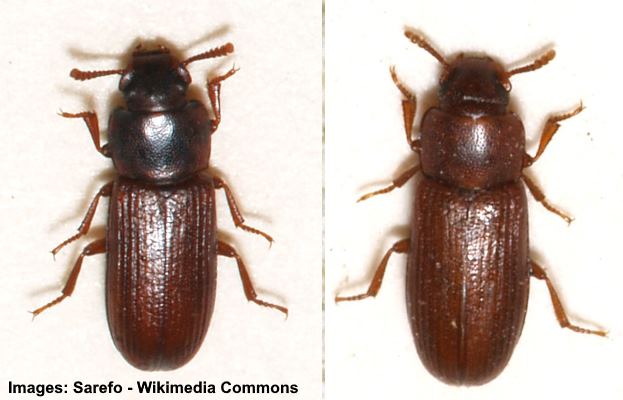
Flour beetles (Tribolium confusum on the left and Tribolium castaneum on the right) are small brown pantry bugs commonly found in flour and in the kitchen cabinets
Red flour beetle is a tiny reddish-brown insect with an oval body, six legs, and two antennae. The pantry beetle measures 0.18” (4.7 mm) long and feeds on flour, cereal, dried fruits, and bran. The rusty-red food pest is one of the most common pantry bugs to infest packets of stored flour.
If you notice white worms in flour, they could be red beetle’s larva — cream-colored maggots measuring 0.25” (6.3 mm) long.
To get rid of red flour beetles, remove infested food packages and thoroughly clean all kitchen units. Keep flour and other dried products in airtight containers to prevent further infestations.
Pantry Bug Identification
The red flour beetle is identified by its elongated oval body that is a uniform rusty-brown color.
Sawtoothed Grain Beetles (Oryzaephilus surinamensis)
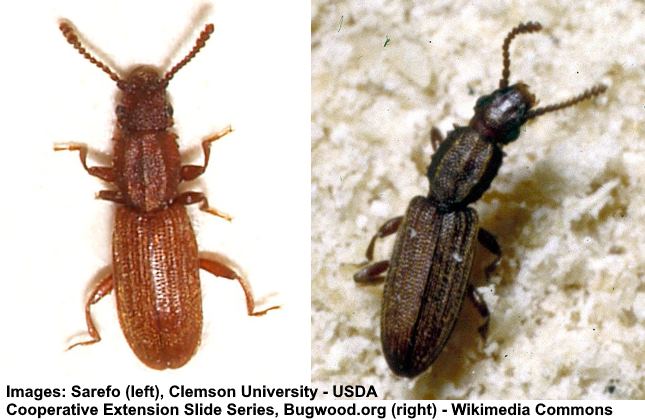
Sawtoothed grain beetles are tiny bugs in the pantry that range in color from rusty brown to dark brown
The sawtoothed grain beetle is a slender, reddish brown or dark brown pantry pest that measures 0.78” to 0.11” (2 – 3 mm) long. An identifying feature is the saw-like teeth on the edges of its prothorax. Pictures of the pantry bug show it’s got a triangular head and segmented antennae.
This pantry bug is a common feeder in cereals, dried meat, seeds, chocolate, and tobacco.
Freezing contaminated food products for four days is an excellent way to kill sawtoothed grain beetle eggs, larvae, and insects.
Pantry Bug Identification
The sawtoothed grain beetle is identified by its slender body, jagged prothorax, and brown to black color.
Cigarette beetles (Lasioderma serricorne)
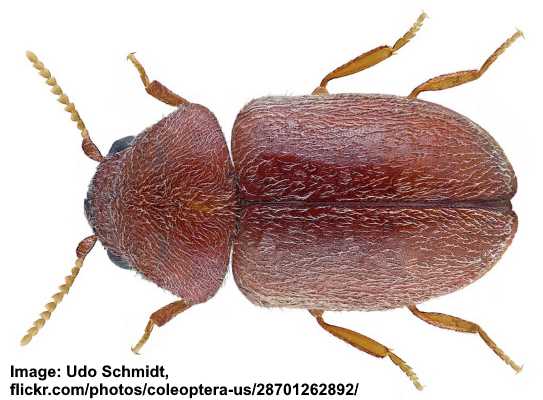
The tiny brown cigarette beetle is attracted to dried tobacco products and dry foodstuffs
The cigarette beetle is a small brown pantry bug with a dark brown, oval body and humped appearance. The tiny brown bugs are 0.13” (3.5 mm) long and are almost impossible to see. Its identifying features are an oval body covered in fine hairs, two serrated antennae, and small round black eyes.
Also called tobacco beetles, these pesky insects are winged pantry bugs that feed on tobacco products, cereals, flour, and sage. They can also fly around kitchens and are attracted to light sources.
The larvae are yellowish-white with a tan-colored head and curved body.
Pantry Bug Identification
The cigarette or tobacco beetle is identified by its stout, rounded appearance, humped shape, and curved body. They look similar to drugstore beetles — another type of pantry bug.
Warehouse Beetle (Trogoderma variabile)
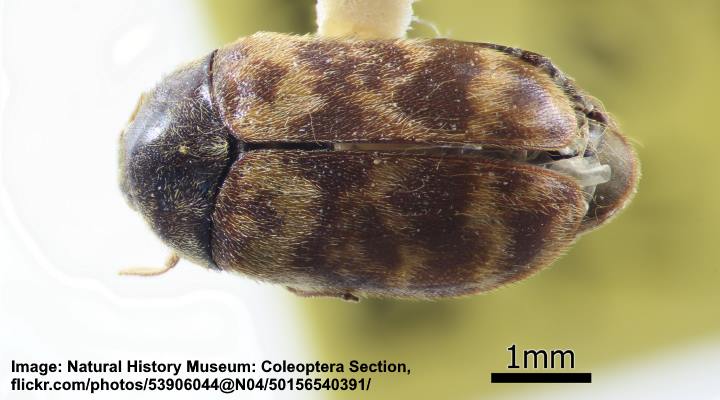
The warehouse beetle is a small pantry pest with light and dark brown patches on its oval body
The warehouse beetle is a tiny brown pantry bug with mottled dark and light brown markings on its fuzzy wing covers. The oval brown bugs measure 0.12” to 0.18” (4.7 mm) long. The destructive pest has a chocolate brown head. It’s commonly found in cereals, seeds, candy, pet foods, and grain products.
Warehouse beetle larvae are pantry worms that are a yellowish to deep brown color and measure 0.25” (6.3 mm) long. These white larvae are also found in dried foodstuffs.
Pantry Bug Identification
The warehouse beetle is an easily identifiable brownish bug with mottled dark brown, beige, and tan colors on its back.
Drugstore Beetle (Stegobium paniceum)

The tiny brown drugstore beetle has a hard shell and is commonly found in packets of dried food products in the kitchen
The drugstore beetle is a cylindrical brown pantry bug with fuzzy wing covers, two segmented antennae, and longitudinal rows of pitted dots and grooves on its back. The brown pantry bugs measure 0.88” to 0.13” (2.25 – 3.5 mm) long. You’ll often find these pesky bugs in seeds, dry pet food, beans, spices, and teas.
Drugstore beetle larvae are small white hairy grubs with creamy-white heads.
As the name suggests, drugstore beetles are commonly found on prescription drugs. However, these pests also attack non-food items and chew through wool, leather, books, and hair.
To get rid of the pantry bugs successfully, you must eliminate the source of the infestation and thoroughly clean the affected surfaces. Other names for the beetle are biscuit beetle, biscuit weevil, and bread beetle.
Pantry Bug Identification
Drugstore beetles are identified by the elongated oval brown body, short three-segmented antennae, and rows of pits on the wing covers.
Spider Beetles
Spider beetles are small black and brown pantry bugs that look like spiders. The identifying characteristics of spider beetle bugs are their rounded bodies, long, segmented antennae, and spider-like appearance. The pantry bugs can be 0.04” to 0.19” (1 – 5 mm) long, depending on the species.
Three common species of spider beetles that are classified as pantry bugs include:
- Smooth spider beetle (Gibbium equinoctial)—A shiny reddish-brown beetle with an enlarged rounded body and pale brown legs and antennae.
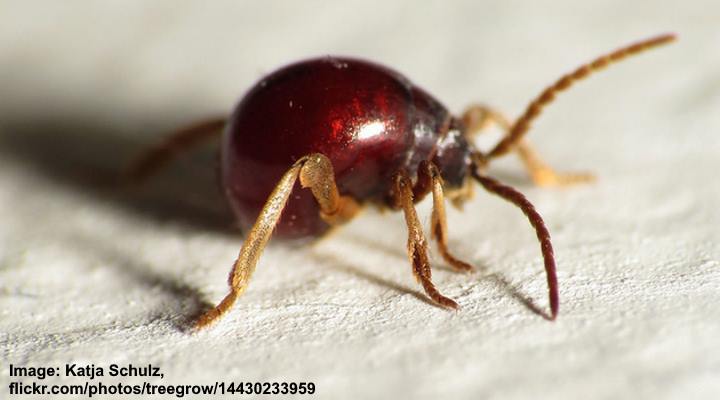
Smooth spider beetle
- American spider beetle (Mezium Americanum)—A chocolatey-brown beetle with fuzzy tan legs and antennae.
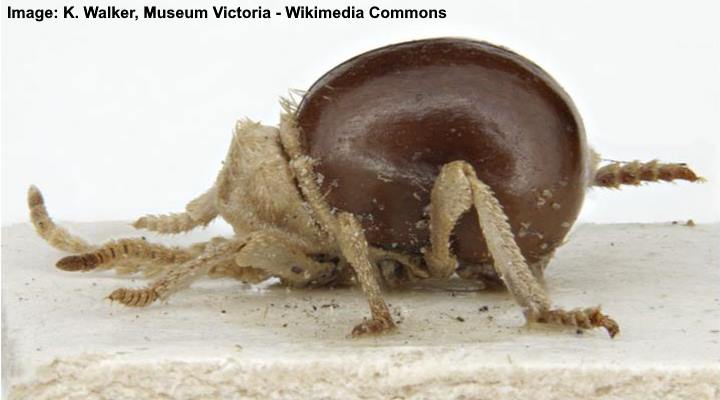
American spider beetle
- Whitemarked spider beetle (Ptinus fur)—This dark-brown pantry bug has an oval body with ridges, white spots, and fine beige hairs.

Whitemarked spider beetle
Pantry Weevils (Flour Bugs)
Pantry weevils are a type of beetle with an identifiable long snout. Like other pantry bugs, the tiny pests grow from worm-like larvae that hatch in contaminated dried grains, cereals, rice, beans, and nuts. Common pantry weevils are rice weevils, granary weevils, maize weevils, and bean weevils.
Granary weevils (Sitophilus granarius)
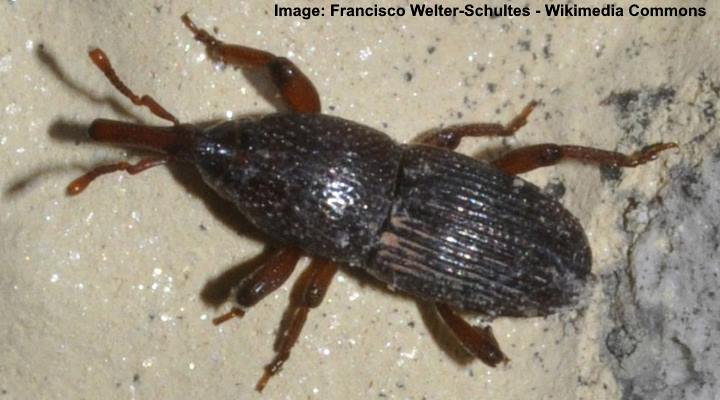
Granary weevils are identified by their brown body with ridges and a long snout
Also called the wheat weevil or grain weevil, this pantry bug is reddish-brown with an elongated snout and stumpy brown legs. The distinguishing marks of the granary weevil are the ridges on its abdomen and pitted marks on its prothorax. These pantry weevils measure 0.12” to 0.2” (3 – 5 mm) long.
Granary weevil larvae are also classed as pantry bugs because they live in packets of dried grains and cereals. The worm-like bugs are white with tan heads.
Pantry Bug Identification
The granary weevil is a small pantry bug with a brown mahogany body, reddish-brown limbs, and a long snout.
Rice weevil (Sitophilus oryzae)
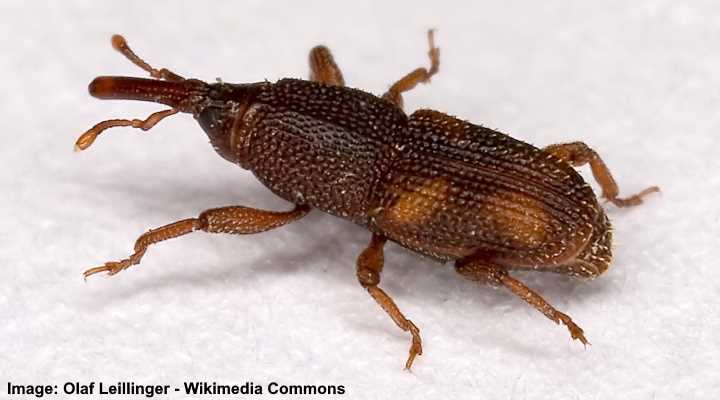
The rice weevil is a small brown pantry bug identified by its elongated snout and pitted body
The rice weevil has a brown or black appearance, long snout, and pitted appearance. Pictures of this pantry bug show it has orangey-red spots on its wing covers. The tiny rice weevil measures between 0.11” and 0.18” (3 and 4.6 mm) long. Its larvae are cream-colored with a dark head and stay inside infested grain kernels.
Rice weevils commonly attack grains like barley, rye, wheat, and other cereal products. In addition, you will sometimes find the pantry bugs in pasta, cashews, nuts, and birdseed.
Pantry Bug Identification
Like all pantry bug weevils, the rice weevil has a characteristic long snout and an elongated oval body.
Maize weevil (Sitophilus zeamais)
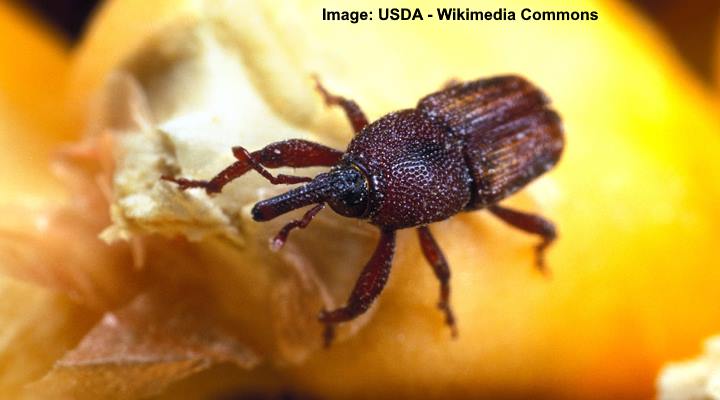
The brown maize weevils are cabinet bugs that infest dried cereal products
The maize weevil looks almost identical to the rice weevil and has a reddish-brown body. However, unlike the rice weevil, the maize pantry weevil has clearly defined ridged markings on its wing covers. The average size of maize weevils is 0.09” to 0.2” (2.3 – 5 mm) long.
Maize weevil larvae are creamy-white and slightly taper to the tail end. The pantry bugs — both the larva and adult — infest grains like buckwheat, rice, wheat, peas, and cottonseed. In your pantry, you may find these bugs in pasta, packets of milled grains, and stored apples.
Pantry Bug Identification
The maize weevil is identified by its dark brown color and lighter ridged markings on its back.
Related: Weevils in Flour (Flour Bugs): Causes and Treatments
Bean weevils (Acanthoscelides obtectus)

The bean weevil has mottled brown and beige body without the elongated snout typical to weevils
The bean weevil is a type of pantry bug with a flattened, egg-shaped body, mottled brown patterns, and two segmented antennae. An identifying feature of bean weevils is their lack of characteristic snout. The broadly oval bodies measure between 0.78” to 0.2” (2 – 5 mm) long.
If you notice milky-white worms or white grubs with brown heads in dried beans and peas, they could be bean weevil larvae.
Pantry Bug Identification
The bean weevil is identified by its oval, egg-shaped body and relatively small triangular head without a snout.
Pantry Moths
Pantry moths are tiny, winged insects that lay eggs in dried foodstuffs — rice, flour, grains, spices, and seeds. The flying food pests hatch into tiny worms or maggots. During the larval stage, the bugs contaminate food by leaving behind frass or droppings. The most common pantry moth is the Indianmeal moth.
Indianmeal Moth (Plodia interpunctella)
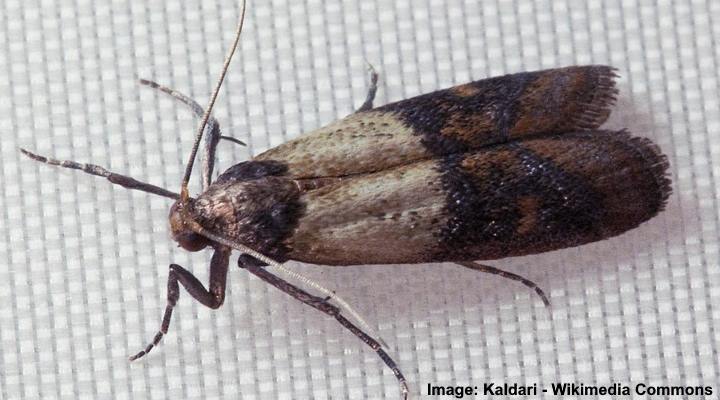
The brown and gray Indianmeal moth is commonly found in kitchens and pantries in grain products
The Indianmeal moth is one of the most common flying pantry bugs. The pantry bug is identified by its coppery-colored and gray-beige wings and measures 0.3” to 0.4” (8 – 10 mm) long. Signs of Indianmeal moth infestations in cereals, grains, and flour are silky webs, dead skin, and frass.
It’s the larvae of Indian meal moths that contaminate cereals. The tiny white larvae are difficult to see when immature. But, under a microscope, you’ll notice they have white bodies and brown heads. However, they can grow up to 0.55” (14 mm) long before pupating.
Flour Mites
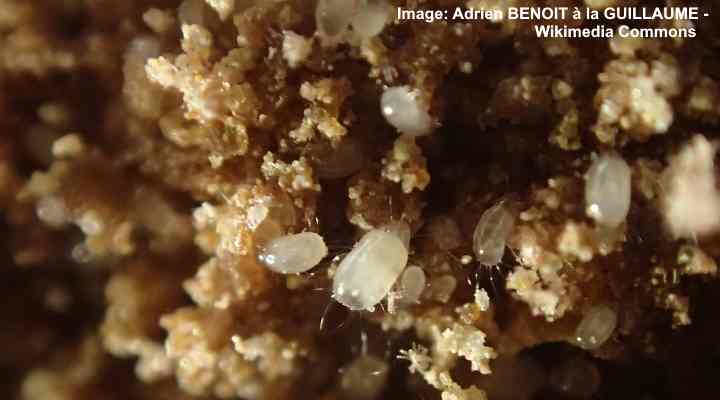
A close up image of Acarus siro, which is a type of grain and flour mite
A flour mite is a tiny translucent white pantry bug, identified by its oval body, clawed legs, and fine hairs. However, the tear-shaped pantry mites are too small to be visible to the naked eye. The white bugs measure 0.013” to 0.017” (0.33 – 0.43 mm) long.
You will notice flour mites only when there is a severe infestation. Then you may see a white powdery substance on kitchen surfaces. The microscopic bugs can attack cheese, flour, powdered milk, and yeast. Another sign of these pantry bugs is that infested products have a strange, bitter taste or emit an unpleasant aroma.
Pantry Ants
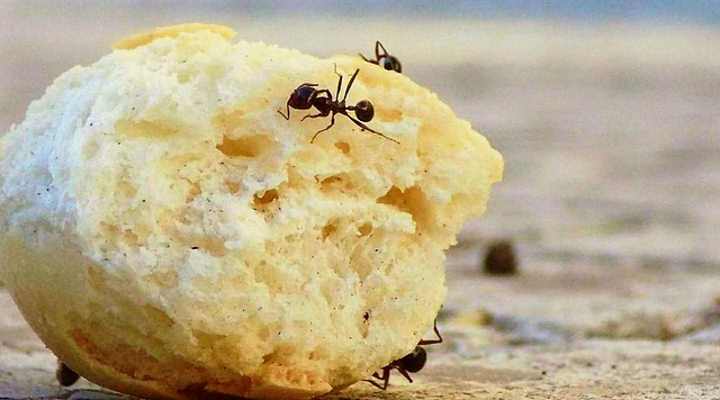
Pantry ants are attracted to many types of food leftovers in the kitchen
Ants are common pantry bugs because they search out sweet foods and water. You may notice the tiny bugs walking in line or teeming around leftover food items on countertops. Pantry ants are attracted to foods like cookies, crackers, jelly, cereals, pet food, and most other food in your pantry.
Common types of ants in pantries include the following:
- Pharaoh ants
- Carpenter ants
- Odorous house ants
- Pavement ants
- Little black ants
Cockroach (Periplaneta)

Common roach (German roach/Blattella germanica) on the left and American roach (Periplaneta americana) on the right
One of the most disgusting pantry bugs is cockroaches. Most cockroaches you find in pantries are slender reddish-brown insects with thin legs and wandering antennae. Common types of disease-carrying pantry cockroaches include the following:
- Common cockroach (Blattella germanica)
- American cockroach (Periplaneta americana)
- Brown cockroach (Periplaneta brunnea)
Cockroaches are also some of the most common types of kitchen bugs.
Related articles:
